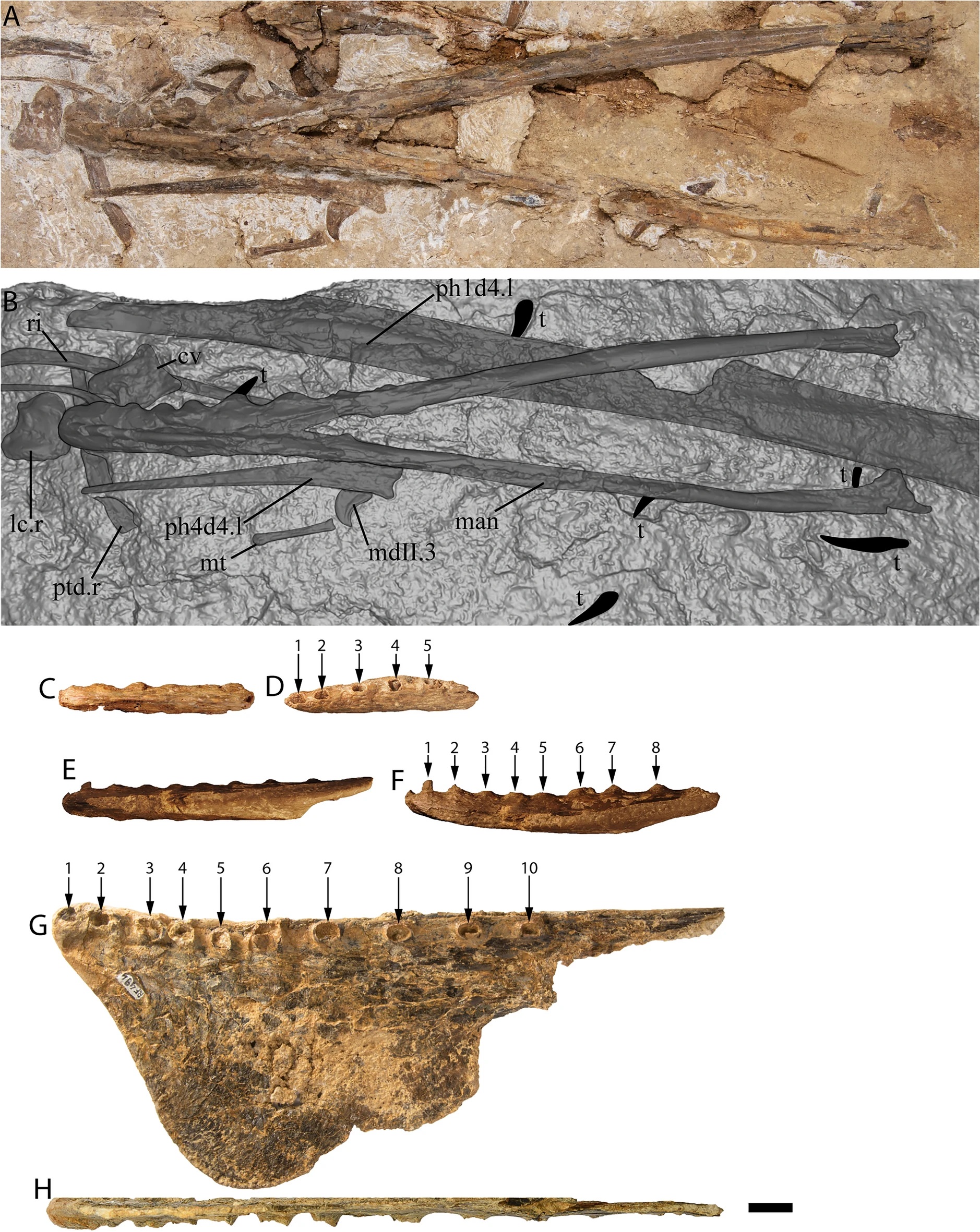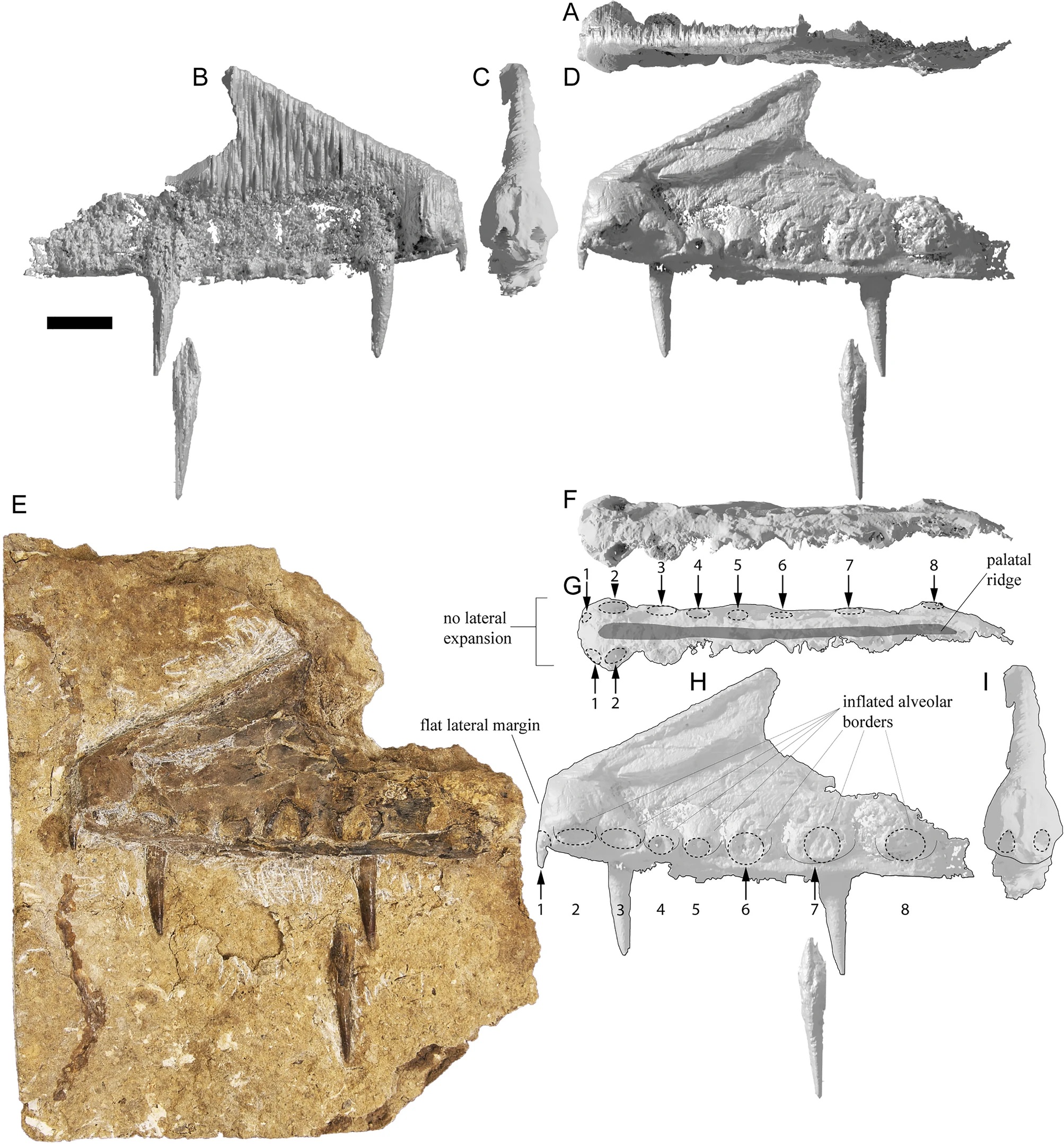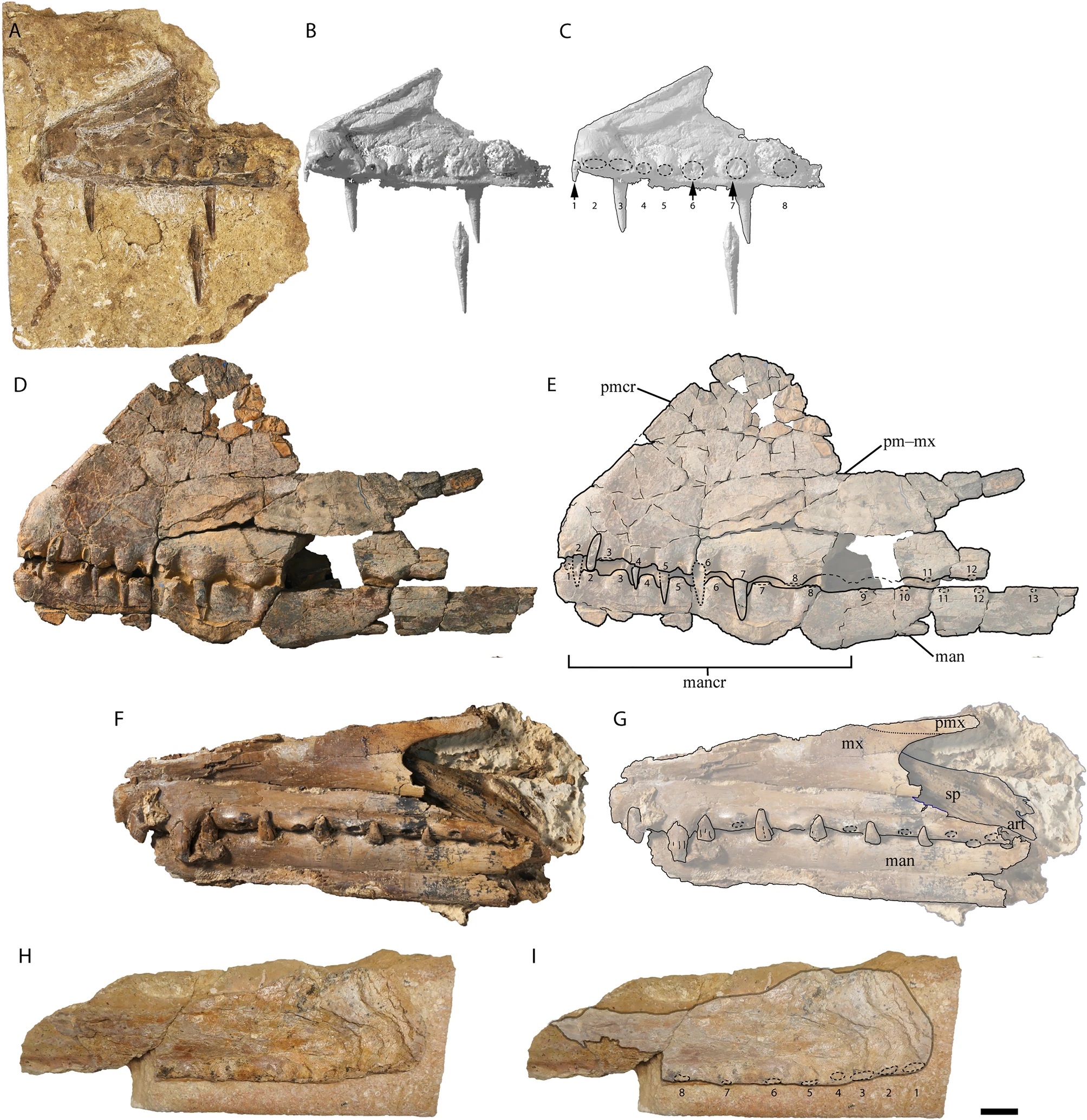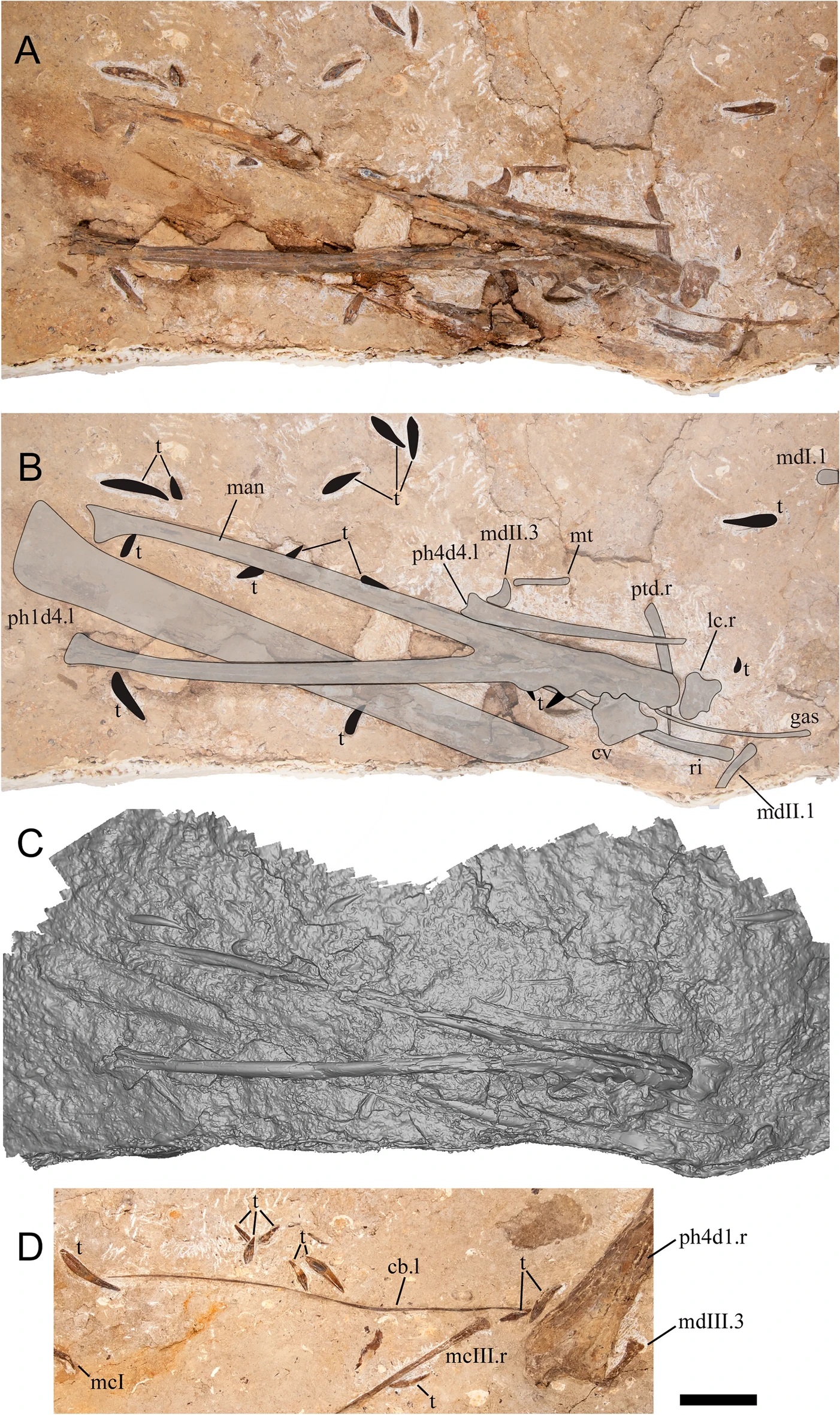Scientists have made a major discovery, identifying fossils of a creature spotted in the skies above the shallow Erumaga Sea, which covers what is now Australia’s barren interior.
“It hunted fish and squid-like cephalopods, and Halescia may have had an advantage and was able to capture live prey in its jaws.”
The creature in question was a flying reptile, a type of pterosaur, that had a bony piece of bone at the end of its upper and lower jaws and a mouth full of spike-shaped teeth, perfect for grabbing fish and other marine prey.
Scientists announced that they made this discovery specifically in the Australian state of Queensland, where they found fossils of this creature that lived with dinosaurs and various marine reptiles during the Cretaceous period.


Australian pterosaur jaws. (A) and (B) Haliskia peterseni mandible – (C) and (D) Aussiedraco molnari mandible – (E) and (F) QM 44423 mandible – (G) and (H) Thapungaka shawi mandible.
Pterosaur remains have been discovered on all continents, but their skeletons are still rare.
Greek origin of the name
The reptile was named Haliskia peterseni, and in fact its name comes from the ancient Greek words ἅлς = “sea” and “shadow”, meaning a ghost or evil spirit, a flying creature that casts a shadow on the sea or a ghost that haunts the Erumaga Sea.
In fact, according to the scientists who conducted the study, which was published this week in the journal Scientific reportsThe remains are the most complete of any pterosaur ever discovered in Australia.
It had a wingspan of 4.6 metres, and lived about 100 million years ago, making Halescia slightly larger and older – by about 5 million years – than the closely related Australian pterosaur, the discovery of which was announced in 2019.
Haleskia means “sea ghost” and this creature may have had a terrifying appearance in the sky above the waves.
“The Erumaga Sea was a huge sea covering large parts of Australia when this pterosaur was alive, but both have disappeared. The specter of both is clear from fossils found in the area,” said Adele Bendland, a doctoral student in paleontology at Curtin University in Australia and lead author of the study. “.


Promaxilla of Haliskia peterseni, (A) dorsal, (B) right lateral, (C) anterior, (D) and (E) left lateral, (F) and (G) ventral, (H) left lateral and (I) anterior Scenery.
The fragile skeletons of pterosaurs are not suitable for fossilization. For Halescia, 22% of the skeleton has been uncovered, with complete lower jaws, the tip of the upper jaw, neck bones, 43 teeth, vertebrae, ribs, bones from both wings, and part of a leg.
“We inferred the presence of a muscular tongue based on the relative length of the neck bones compared to the length of the lower jaw,” Bendland said in a statement. Reuters.
“The prey trapped in its jaws”
“In many other pterosaurs, the neck bones are 30% or 60% of the length of the lower jaw, while in Halescia the neck bones are 70% of the length of the lower jaw. “This means that while hunting fish and squid-like cephalopods, they may have been “Halyskia has the advantage and was able to capture live prey in its jaws.”
She said she was “surprised” that the Haleskia specimen preserved neck bones. “It’s as thin as a piece of spaghetti, and one whole from end to end.”
The remains of Haleskia are more complete than those of Verodraco. Both are members of a group of pterosaurs called Anhanguerians, known from fossils found in China, the United States, Brazil, England, Spain and Morocco. The other three Australian pterosaurs are known only from a few jaw bones, Bendland said.
After his death, Haleskia’s body ended up buried under sediment at the bottom of the Erumaga Sea, allowing him to turn into a fossil. The creature’s name also honors Kevin Petersen, an avocado farmer turned curator at Kronosaurus Corner Museum, whose remains were discovered in 2021.


Cranial materials of Australian pterosaurs (A), (B), and (C) Halyskia premaxilla and teeth- (D) and (E) Ferrodraco lentoni premaxilla-maxilla and mandible- (F) and (G) Skull of Mithunga camara and maxilla. – (h) and (i) Primaxilla.
Pterosaurs had the same fate as dinosaurs
Pterosaurs were the first of the three groups of vertebrates to fly, and appeared about 230 million years ago. Birds appeared about 150 million years ago, and bats about 50 million years ago. Pterosaurs disappeared in the same mass extinction event that wiped out the dinosaurs, except for their descendants, birds, 66 million years ago after they were struck by an asteroid.


Haleschia petersini (mandible) and left brachial cornea. Images A, B, D and 3D surface rendering.
“Pterosaurs occupied different positions in the food chain, with small ones feeding on insects, others being piscivores and feeding on fish, and others being scavengers. The smallest had a wingspan of about 25 cm, while the largest “Pterosaurs had a wingspan that rivaled that of a small fighter plane, and were the largest animals that ever took to the skies.”
Knowledge of Haleskia helps understand life in Australia during the Mesozoic era, when dinosaurs ruled the land. He added: “This discovery is important, as it was thought for many years that Australia had very few fossils dating back to the age of dinosaurs.”





More Stories
In Greece Porsche 911 50th Anniversary – How much does it cost?
PS Plus: With a free Harry Potter game, the new season begins on the service
Sony set to unveil PS5 Pro before holiday season – Playstation